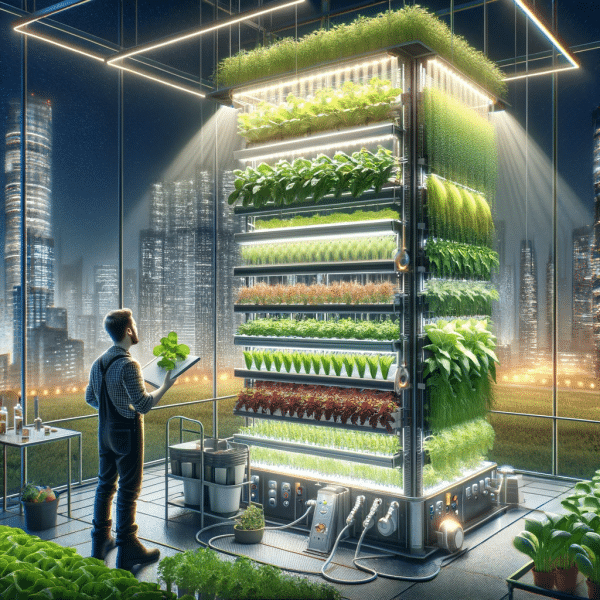
Vertical Farming Revolution: Growing More with Less Space and Resources
Have you ever looked at your backyard or a vacant corner of your apartment and thought, "I wish I could grow my own fresh produce right here"? Well, you're not alone. Many of us crave self-sufficiency and dream of reducing our carbon footprint. But what if I told you there's a revolutionary way to achieve this without needing acres of land or excessive resources?
Welcome to the world of vertical farming, where the age-old concept of agriculture takes a leap into the future. In this article, we'll embark on a journey into the heart of this fascinating agricultural revolution. We'll explore how vertical farming offers a solution to the challenges of traditional agriculture and discover why it has captured the imagination of those who desire self-sufficiency and a greener planet.
Picture this: traditional farming, with its vast expanses of fields and heavy reliance on pesticides and excessive water, has often been seen as a necessary evil. It's resource-intensive, laborious, and sometimes detrimental to the environment. But what if we could flip the script and turn this age-old practice on its head?
Vertical farming does just that. It's like taking the principles of a high-rise building and applying them to agriculture. Think of it as farming in 3D, where crops aren't limited to the horizontal plane but instead reach for the sky. This innovation allows us to maximize space utilization, reduce water consumption, and minimize our environmental impact.
But why is vertical farming gaining so much attention now? What makes it the perfect solution for those who seek self-sufficiency and a reduced carbon footprint?
The Vertical Farming Advantage
Now that you've got a taste of what vertical farming is all about, let's dive into the heart of its advantages. Imagine traditional farming as an old, gas-guzzling car struggling to get you from point A to B. It chugs along, consuming more fuel than it should, leaving a trail of emissions in its wake. Vertical farming, on the other hand, is like upgrading to a sleek, energy-efficient electric vehicle.
The key to understanding the vertical farming advantage lies in its efficiency. Picture a vertical farm as a stack of plant-filled shelves, each layer perfectly tuned to provide the ideal environment for crops. Here's where the magic happens. Traditional farming devotes vast areas to a single crop, but vertical farming uses every inch wisely. It's like turning a small apartment into a multi-functional space where every nook serves a purpose.
Water, the lifeblood of agriculture, is often wasted in traditional farming. But in the vertical farming universe, it's a precious resource. Through clever design and technology, vertical farms use significantly less water. Think of it as watering your garden with a dropper instead of a hose. This not only conserves water but also reduces the strain on our planet's dwindling freshwater reserves.
Speaking of resources, vertical farming also minimizes the need for synthetic pesticides. Picture a traditional field as a battleground where pesticides are deployed to fend off pests and diseases. Vertical farms, with their controlled environments, are more like a well-guarded fortress, where the need for chemical warfare is greatly diminished. It's a win-win for both your health and the environment.
But the vertical farming advantage doesn't stop there. Imagine getting your fresh vegetables and herbs from the farm to your table in a matter of hours, not days. Vertical farms are often located closer to urban areas, reducing the carbon footprint of transportation. It's like having a farmer's market right at your doorstep, with produce that's as fresh as can be.
Embracing the Future
As we've journeyed through the world of vertical farming, you might be wondering, "Is this the future of agriculture?" Well, the answer is a resounding yes. Vertical farming isn't just a fad; it's a sustainable and efficient way forward. Imagine it as the evolution from a flip phone to a smartphone - a change that redefines the way we connect with the world.
One of the driving forces behind the future of vertical farming is technology. Picture traditional farming as a manual typewriter, where each keystroke demands physical effort. In contrast, vertical farming is like a high-speed computer, where automation, data analytics, and precision control take center stage. Sensors monitor every aspect of plant growth, adjusting conditions in real-time for optimal results.
But it's not just about technology; it's about rethinking agriculture for a crowded, urbanized world. Vertical farms can be established in the heart of cities, reducing the distance between the farm and your plate. Imagine the benefits of locally grown, fresh produce without the need for long-haul transportation. It's like having a farm in the middle of a bustling metropolis.
Of course, no innovation is without its challenges. Vertical farming requires energy for lighting, climate control, and other systems. But here's where sustainability comes into play. Renewable energy sources like solar panels can power these farms, further reducing their carbon footprint. It's akin to turning sunlight into food, a marvel of modern agriculture.
So, are you ready to embrace the future of farming, one where self-sufficiency and a low carbon footprint go hand in hand? Vertical farming offers a tantalizing glimpse into what's possible, and it's a movement that's growing stronger every day. The next time you look at that empty corner of your apartment or the unused space in your backyard, remember that it could be a thriving vertical farm, providing you with fresh, healthy, and sustainable food.
In conclusion, the vertical farming revolution isn't just about growing more with less space and resources; it's about reshaping our relationship with food and the environment. It's a testament to human ingenuity and our ability to adapt to a changing world. So, as you ponder your own journey towards self-sufficiency and a greener planet, consider taking a vertical leap into the future of farming. Your plate, and the planet, will thank you.
